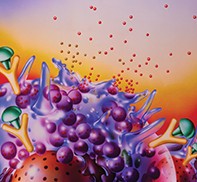Leukotriene receptor antagonists in childhood asthma
Asthma is now the most common chronic disease of childhood. Much of this disease is frequent episodic virus-triggered and mild persistent disease. These two patterns of asthma primarily involve children between the ages of 2 and 7 years, with children older than 7 years more represented in moderate to severe persistent disease.
Leukotrienes in asthma
Asthma is an inflammatory disease of the airways that involves a number of inter-related inflammatory cascades. For 40 years, ‘slow reacting substance of anaphylaxis’ (SRSA) has been known to produce acute bronchoconstriction and mucous hypersecretion in patients with asthma. SRSA is now known to be the cysteinyl leukotrienes. These are highly reactive metabolites of arachidonic acid that are released from activated eosinophils and mast cells in both immediate and delayed airway inflammation in asthma. The cysteinyl leukotrienes bind to target receptors in the bronchial smooth muscle and airway mucous glands, resulting in acute bronchoconstriction and hypersecretion. This particular inflammatory pathway appears not to be impacted in a major way by either oral or inhaled corticosteroid therapy. Moreover, this pathway may play a prominent part in the airway inflammation of a significant number of asthmatic children.

